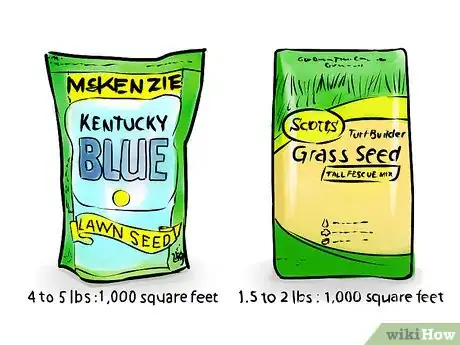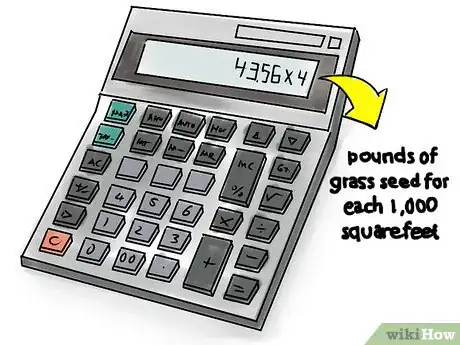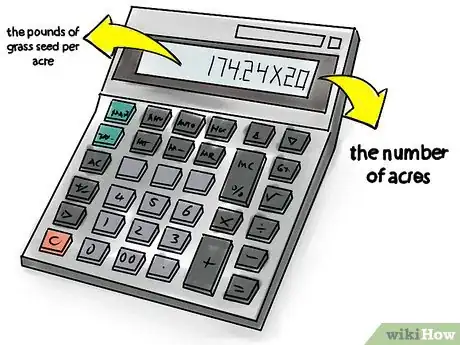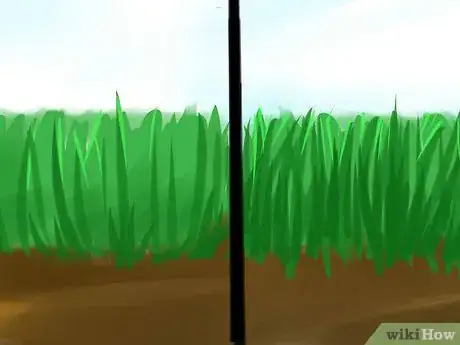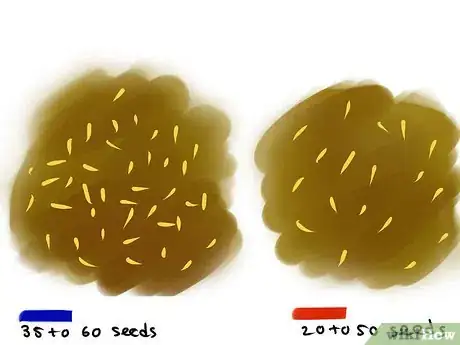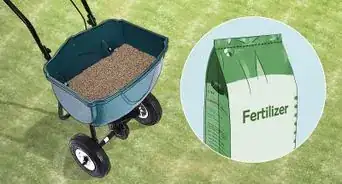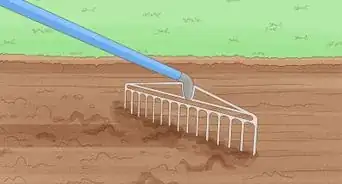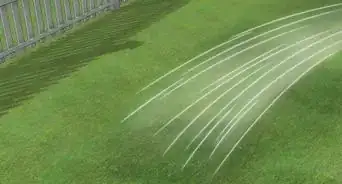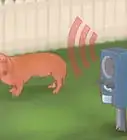X
wikiHow is a “wiki,” similar to Wikipedia, which means that many of our articles are co-written by multiple authors. To create this article, volunteer authors worked to edit and improve it over time.
This article has been viewed 195,838 times.
Learn more...
Grass seed calculations are often based on square footage or square meters for small residential lawns. But, for big land-bases such for large properties with large lawns, parks and golf courses, it's important to know how to calculate amount of grass seed needed per acre or hectare. This information will help you know how much to buy and to estimate costs.
Steps
-
1Learn the amount of acreage (or hectares) in the land that is to be seeded.
- Total acreage (or hectares) is listed in land survey details and is available from the county office or in your municipality's land records department.
- You can also measure the land yourself or hire a surveyor to provide this information to aid in calculating amount grass seed needed.
-
2Check the grass seed rate on the bag or with the grass seed manufacturer.[1]
- For example, Kentucky bluegrass is often recommended at 1.5 to 2 lb (0.680 or 0.907 kg) per 1,000 square feet (92.9 square meters); turf-type tall fescue is 6 to 8 lb (2.7 kg to 3.6 kg) per 1000 square meters.
- Most grass seed label mixes recommend 4 to 5 lb (1.8 to 2.2 kg) of grass seed for each 1,000 square feet (92.9 square meters) of land.
Advertisement -
3Since one acre = 43,560 square feet, first begin dividing 1000 square feet by 43,560 to get 43.56. Then multiply 43.56 by the pounds of grass seed for each 1,000 square feet to get the amount of grass seed needed per acre.[2]
- For example, if you have a grass seed mixture that recommends 4 lb per 1,000 square feet, then you would need 43.56 x 4 = 174.24 lb of grass seed per acre.
- Working in metric, consider that 1000 square feet = 92.90 square meters, and 1 hectare = 2.47 acres. So if the label tells you 4 lb of grass seed for 1000 square feet, that equates to 1.81 kg per 92.90 square meters. If you need to calculate amount of grass seed needed per hectare, then you will need to calculate it out via a longer method:[3]
- 1.81 kg ÷ 92.90 square meters = 0.0195 kg/square meters; since 1 hectare = 10,000 square meters, 0.0195 x 10,000 = 195 kg of seed is needed per hectare.
-
4Calculate the seeding rate by multiplying the number of acres (or hectares) by the pounds (kilograms) of grass seed per acre (hectare).[4]
- For example, if you had 2 acres (0.81 ha) of land, from the above grass seed calculation, you would multiply 174.24 lb/acre by 2 acres to get 348.48 lb. If you had 50 acres, then 174.24 x 50 = 8,712 lb of grass seed.
- Going by imperial, about 174 lb/acre = 195 kg/ha; so, since 2 acres = 0.81 hectares, then 195 kg/ha x 0.8 = 157.95 kg; if you had 50 acres = 20.23 ha, then you would need 195 kg/ha x 20.23 ha = 3,944.85 kg of grass seed.
- Round up to the next pound, i.e. 348.48 lb (157.95 kg) would be 349 lb (158 kg).
- For example, if you had 2 acres (0.81 ha) of land, from the above grass seed calculation, you would multiply 174.24 lb/acre by 2 acres to get 348.48 lb. If you had 50 acres, then 174.24 x 50 = 8,712 lb of grass seed.
-
5Know that the purpose of the seeding is also important in determining grass seed calculations. Turf grass for a golf course or football field needs to be denser that the median between lanes of traffic or a slope.
- Erosion control and landscaping are two different purposes that affect the seeding rate.
- Basically, less seed is needed for erosion control than for landscaping.
- For forage production or wild-land meadows, you only need 10 to 20 lb of of grass seed per acre. Some intensive forage production requires more, such as 30 to 40 lb of seed per acre, especially when growing hay for export markets or to sell for making feed pellets or cubes.
- Erosion control and landscaping are two different purposes that affect the seeding rate.
-
6Understand the differences between cool season and warm season grasses.[5]
- Cool-season (C3) grasses are better adapted to cooler climates with harsh winters. Kentucky Bluegrass, Creeping Red Fescue and Tall Fescue are cool-season grasses adapted to cool climates, and are highly recommended for lawns in such areas. Perennial ryegrass is also a cool-season grass, however in climates where winters are too severe for long-term survival, it would not fare well as a lawn grass.
- Warm-season (C4) grasses are adapted to southern climates with a mild year-round climate. Bermuda-grass, Centipede-grass, and Zoysia-grass are warm-season grasses adapted to southern climates, like in the southern USA. They are also drought-tolerant, and withstand cooler temperatures better than other warm-season grasses.
-
7Consider attributes of the land and the species selected in order to fine-tune grass seed calculations.
- Soil type, slope, soil fertility, climate (with regards to location) should be known in order to plan out what seed is needed for your lawn. Shady locations and moisture of the soil will also affect seeding rate.
- Pure live seed rate (PLS), number of seeds per pound, and adaptability of the species selected will influence success rate of grass seed. As mentioned just above, fertility is also needed to determine if fertilizer is needed in addition to the seed put down.
- PLS is needed to be known to fine-tune how much seed you will need to sow. The higher the rate (meaning, the more live seed there is) the more accurate you will be for the amount of seed that needs to be sown. But if PLS, based on a percentage, is lower, you will need more seed for a better success rate.
- In regards to number of seeds per pound (kilogram), the more seeds there are per pound or kilogram, the less seed needed for sowing lawn or pasture.
Advertisement
Community Q&A
-
QuestionIf I have 80,000 sq ft, how many pounds of seed at 8 lbs per 1000 sq ft do I need?
 KarinTop Answerer640 pounds. If, that is, you are actually planting turf-type tall fescue. If you're using grass with smaller seeds, like Kentucky bluegrass, then you only need 2 lb of seed per 1000 sq ft; which gives you only 160 lb of seed. Think of it this way: There are 225,000 tall fescue seeds per pound, whereas there are around 2,180,000 kentucky bluegrass seeds per pound. So you need more of the larger seed to cover the same area as you would with less of the smaller seed.
KarinTop Answerer640 pounds. If, that is, you are actually planting turf-type tall fescue. If you're using grass with smaller seeds, like Kentucky bluegrass, then you only need 2 lb of seed per 1000 sq ft; which gives you only 160 lb of seed. Think of it this way: There are 225,000 tall fescue seeds per pound, whereas there are around 2,180,000 kentucky bluegrass seeds per pound. So you need more of the larger seed to cover the same area as you would with less of the smaller seed. -
QuestionHow much grass seed is needed for 5200 sq. ft of grass?
 KarinTop AnswererHere's the math, using similar values above, but in a different way: (4 lb ÷ 1000 square feet) = 0.004 lb/sq ft. So, 5200 x 0.004 = 20.8 lb of grass seeded needed.
KarinTop AnswererHere's the math, using similar values above, but in a different way: (4 lb ÷ 1000 square feet) = 0.004 lb/sq ft. So, 5200 x 0.004 = 20.8 lb of grass seeded needed. -
QuestionHow many kgs of seeds can be put in a hectare?
 KarinTop AnswererThat all depends on the species of choice! As mentioned in the article above, an average rate of 4 lb per 1000 square feet works out to 195 kg of seed per hectare - for lawn only. If you're putting down pasture or hayland, that's way, way too much seed. Figure instead on a rate of ~20 lb per acre.
KarinTop AnswererThat all depends on the species of choice! As mentioned in the article above, an average rate of 4 lb per 1000 square feet works out to 195 kg of seed per hectare - for lawn only. If you're putting down pasture or hayland, that's way, way too much seed. Figure instead on a rate of ~20 lb per acre.
Advertisement
Warnings
- More seed per square foot or acre isn't always better. Overcrowded grass plants have much greater competition among each other for nutrients, sunlight, and moisture, which may be conducive to stress. Stressed plants are more prone to disease and fungal issues, regardless how much more moisture and fertilizer is put on for them.⧼thumbs_response⧽
Advertisement
References
- ↑ https://www.pennington.com/all-products/grass-seed/resources/learn-the-importance-of-a-seed-tag
- ↑ https://www.americanmeadows.com/how-much-seed-do-i-need
- ↑ http://www.gardenguides.com/94200-calculate-grass-seed-per-acre.html
- ↑ https://extension.psu.edu/turfgrass-seed-and-seed-mixtures
- ↑ https://www.thelawninstitute.org/pages/education/types-of-grasses-and-species-selection/cool-and-warm-season-grasses/
About This Article
Advertisement

